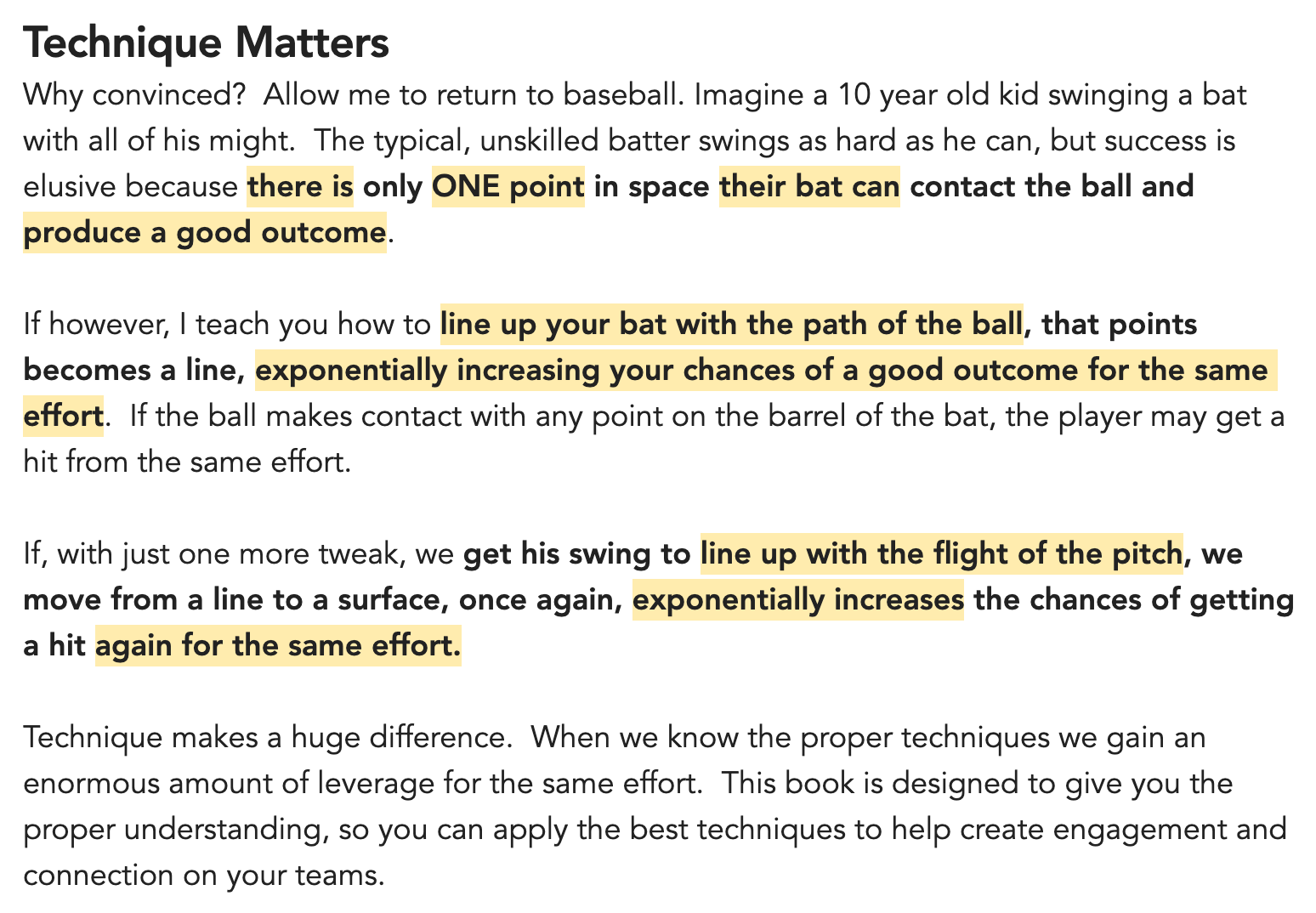While I use the Zettlekasten method to link ideas into thought trains, I also use something called Progressive Summarization to make the information in my notes more discoverable, and therefore useful over time.
Why It Matters:
Once upon a time I was reading a terrific book by Eckhart Tolle. He shared a story that affected me deeply. Within that story was an anecdote, a way of thinking. I wanted to remember the lesson, but reading back through the book to find the story was too cumbersome, and reciting the whole story made the lesson hard to share. I needed a way to get to the gist of the story fast without losing its significance or context.
Hello Progressive Summarization.
What is Progressive Summarization?
Progressive summarization is when you take a block of text and use TWO levels of highlighting. Most note taking apps support bold and highlights. Personally, I use bold to mark out the key block of text I want to focus on. Then I use highlights to condense the idea to its essence. This allows me to quickly scan a block of text - and grab the gist of an idea fast. This is best demonstrated with an example.
I will use some of my own content to demonstrate. From my upcoming book Work at Play, you will find the following text in the Introduction. What this next block of text demonstrates is
- I use bold to grab the key ideas of the content I want to work with.
- I then use highlights to stitch together the ideas into the most concise statement I can.
Example of Progressive Summarization
The image below shows what a progressively summarized note looks like in Obsidian. (Yes, I'm old school, I still prefer light theme)

How you use this
If you focus on the bold lines, you get something like:
- there is only ONE point in space their bat can contact the ball and produce a good outcome. line up your bat with the path of the ball, that points becomes a line, exponentially increasing your chances of a good outcome for the same effort. get his swing to line up with the flight of the pitch, we move from a line to a surface, once again, exponentially increases the chances of getting a hit again for the same effort.
We reduced 203 words to 80.
Focus on the highlighted lines and you get:
- there is one point their bat can produce a good outcome. Line up your bat with the path of the ball exponentially increases your chance of a good outcome for the same effort. Line up with the flight of the pitch exponentially increases again for the same effort.
We reduced the word count from 80 to 48.
Progressive summarization allows us to distill an idea down to its essence while preserving its context. If you focus on the bold, and then the highlights, you can see how you have created a skimmable version of the text which can produce the essence of the information quickly.
The Big Picture
The reality is Zettlekasten (ZK for brevity) and PARA are not incompatible. I use them together. The main difference is that the ZK encourages you to isolate ideas on single notes. Progressive summarization asks you to preserve the context of an idea but make it easier and faster to digest.
What do you highlight?
When we read a bit of text in a book, or on the web, very often it is a few lines that jump out at us. In the old school days of physical media, we might use a highlighter to mark the passages that resonate with us. Sometimes the author does this for us. Sometimes, if you use an eReader, you will see passages that are most highlighted. But the reality is, these are your notes, so I put special emphasis on the idea to mark what resonates with me. To me, resonance is a feeling of significance I get when I read certain passages or phrases. What resonates is different for each of us.
How To:
How do I use this in practice?
- I use readwise.io and highlight liberally in my kindle.
- Readwise then exports those highlights (with content limitations) to Obsidian.
- When I create a thought train for a book, I use the text from readwise to flesh out my "cards" (note files).
- If see something impactful, I progressively summarize that content to get to the gist of it.
Two other tips:
- I also use the extension MarkDownload - Markdown Web Clipper (google.com) to grab web content. I will admit, Obsidian does not have a great web clipper. Notion.so and Evernote do much better, but this lets me save blog posts, articles, and text content I find on the web.
- I also use Instapaper to highlight web article (like kindle highlights) which readwise will send to Obsidian automagically.
Takeaway:
Progressive summarization is something I do to make my notes more valuable over time. When I refer to, encounter, or connect a note, I often take a few moments to improve the note by adding these layers of highlighting (bold, then highlight). Progressive summarization is a tool I use to make my notes more actionable and valuable.
Go Deeper:
- 🔗 key links 📘 https://amzn.to/47EGU9o




